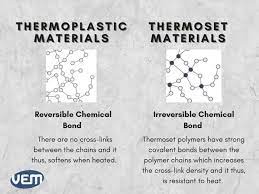
The Versatility of Thermoplastics in Modern Manufacturing
Thermoplastics are a class of polymers that soften when heated and harden when cooled, making them highly versatile materials in various industries. Their ability to be molded and reshaped multiple times distinguishes them from thermosetting plastics, offering flexibility and ease of processing.
Applications Across Industries
From automotive components to packaging materials, thermoplastics find applications in a wide range of industries. In the medical field, they are used for manufacturing disposable syringes and IV tubes due to their sterile properties and ease of customization. In construction, thermoplastic pipes are favored for their durability and resistance to corrosion.
Environmental Benefits
One significant advantage of thermoplastics is their recyclability. Unlike thermosetting plastics that undergo irreversible chemical changes during processing, thermoplastics can be melted down and reshaped multiple times without losing their properties. This characteristic makes them a sustainable choice for environmentally conscious manufacturers.
Innovations in Thermoplastic Technology
Advancements in polymer science have led to the development of high-performance thermoplastics with enhanced mechanical properties and chemical resistance. Materials such as PEEK (Polyether Ether Ketone) and ULTEM (Polyetherimide) are increasingly used in aerospace, electronics, and other demanding industries due to their exceptional strength-to-weight ratios.
The Future of Thermoplastics
As research continues to push the boundaries of material science, we can expect further innovations in the realm of thermoplastics. From biodegradable options to smart polymers capable of responding to external stimuli, the future holds exciting possibilities for this versatile class of materials.
6 Essential Tips for Understanding and Using Thermoplastics
- Thermoplastics can be melted and reshaped multiple times, unlike thermosetting plastics.
- Common thermoplastics include polyethylene, polypropylene, PVC, and polystyrene.
- They are widely used in manufacturing due to their versatility and ease of processing.
- Thermoplastics are recyclable and environmentally friendly compared to thermosetting plastics.
- Heating thermoplastics softens them for molding but cooling solidifies the material again.
- Proper storage of thermoplastics is essential to prevent degradation from exposure to heat or UV light.
Thermoplastics can be melted and reshaped multiple times, unlike thermosetting plastics.
Thermoplastics offer a unique advantage over thermosetting plastics in that they can be melted and reshaped multiple times without undergoing any chemical changes. This characteristic allows for greater flexibility and reusability in manufacturing processes, making thermoplastics a preferred choice for industries seeking materials that can be easily molded and modified to meet specific requirements. The ability to repeatedly melt and reshape thermoplastics not only enhances their versatility but also contributes to their sustainability by enabling efficient recycling and waste reduction practices.
Common thermoplastics include polyethylene, polypropylene, PVC, and polystyrene.
Common thermoplastics such as polyethylene, polypropylene, PVC, and polystyrene play integral roles in various industries due to their unique properties and versatility. Polyethylene, known for its flexibility and impact resistance, is widely used in packaging and construction. Polypropylene, valued for its high heat resistance and chemical inertness, finds applications in automotive parts and food containers. PVC, with its excellent durability and weather resistance, is commonly used in piping systems and medical devices. Polystyrene, prized for its lightweight nature and insulation properties, is prevalent in packaging materials and consumer goods. These thermoplastics demonstrate the diverse range of characteristics that make them essential materials in modern manufacturing processes.
They are widely used in manufacturing due to their versatility and ease of processing.
Thermoplastics are extensively utilized in manufacturing industries owing to their remarkable versatility and ease of processing. These materials can be molded and reshaped multiple times, making them highly adaptable to various production processes. The ability of thermoplastics to soften when heated and harden when cooled allows manufacturers to efficiently create complex shapes and designs with precision. This characteristic not only enhances the flexibility in manufacturing operations but also contributes to cost-effectiveness and time efficiency in the production of a wide range of products.
Thermoplastics are recyclable and environmentally friendly compared to thermosetting plastics.
Thermoplastics offer a sustainable solution in the realm of plastic materials due to their recyclability and eco-friendly nature, setting them apart from thermosetting plastics. The ability of thermoplastics to be melted down and reshaped multiple times without compromising their properties makes them a valuable choice for manufacturers looking to reduce waste and environmental impact. By opting for thermoplastics over thermosetting plastics, industries can contribute to a more sustainable future while still meeting their production needs effectively.
Heating thermoplastics softens them for molding but cooling solidifies the material again.
When working with thermoplastics, it is essential to understand that heating the material softens it, allowing for molding and shaping according to desired specifications. However, once the thermoplastic is cooled, it solidifies again, retaining the new form imparted during the molding process. This unique property of thermoplastics enables manufacturers to repeatedly heat and reshape the material without compromising its structural integrity, making them a versatile choice for various industrial applications.
Proper storage of thermoplastics is essential to prevent degradation from exposure to heat or UV light.
Proper storage of thermoplastics is crucial to maintaining their quality and performance over time. Exposure to heat or UV light can lead to degradation of the material, affecting its mechanical properties and appearance. By storing thermoplastics in a cool, dry place away from direct sunlight, manufacturers can ensure that the integrity of the material is preserved, ultimately extending its lifespan and usability in various applications.
